Microsoft RM-180 GSM 900/1800/1900 wBT User Manual R1140 en
Microsoft Mobile Oy GSM 900/1800/1900 wBT R1140 en
Manual

DOCUMENTTYPE 1 (1)
TypeUnitOrDepartmentHere
TypeYourNameHere TypeDateHere
Nokia N72 User Guide
R1140_en.book Page 1 Thursday, March 23, 2006 9:52 AM

DOCUMENTTYPE 1 (1)
TypeUnitOrDepartmentHere
TypeYourNameHere TypeDateHere
DECLARATION OF CONFORMITY
Hereby, NOKIA CORPORATION, declares that this
RM-180 product is in compliance with the
essential requirements and other relevant
provisions of Directive 1999/5/EC. A copy of the
Declaration of Conformity can be found at http://
www.nokia.com/phones/
declaration_of_conformity/
The crossed-out wheeled bin means that within the European Union the
product must be taken to separate collection at the product end-of-life.
This applies to your device but also to any enhancements marked with
this symbol. Do not dispose of these products as unsorted municipal
waste.
Copyright © 2006 Nokia. All rights reserved.
Reproduction, transfer, distribution or storage of part or all of the contents in this
document in any form without the prior written permission of Nokia is prohibited.
Nokia, Nokia Connecting People, Pop-Port, and Visual Radio are trademarks or
registered trademarks of Nokia Corporation. Other product and company names
mentioned herein may be trademarks or tradenames of their respective owners.
Nokia tune is a sound mark of Nokia Corporation.
This product includes software licensed from Symbian Software Ltd (c) 1998-
200(6). Symbian and Symbian OS are trademarks of Symbian Ltd.
Java™ and all Java-based marks are trademarks or registered trademarks of Sun
Microsystems, Inc.
Bluetooth is a registered trademark of Bluetooth SIG, Inc.
Stac ®, LZS ®, ©1996, Stac, Inc., ©1994-1996 Microsoft Corporation. Includes one
or more U.S. Patents: No. 4701745, 5016009, 5126739, 5146221, and 5414425.
Other patents pending.
Hi/fn ®, LZS ®,©1988-98, Hi/fn. Includes one or more U.S. Patents: No. 4701745,
5016009, 5126739, 5146221, and 5414425. Other patents pending.
Part of the software in this product is © Copyright ANT Ltd. 1998. All rights reserved.
US Patent No 5818437 and other pending patents. T9 text input software Copyright
(C) 1997-2006 Tegic Communications, Inc. All rights reserved.
This product is licensed under the MPEG-4 Visual Patent Portfolio License (i) for
personal and noncommercial use in connection with information which has been
encoded in compliance with the MPEG-4 Visual Standard by a consumer engaged
in a personal and noncommercial activity and (ii) for use in connection with
MPEG-4 video provided by a licensed video provider. No license is granted or shall
be implied for any other use. Additional information, including that related to
promotional, internal, and commercial uses, may be obtained from MPEG LA, LLC.
See <http://www.mpegla.com>.
Nokia operates a policy of ongoing development. Nokia reserves the right to make
changes and improvements to any of the products described in this document
without prior notice.
Under no circumstances shall Nokia be responsible for any loss of data or income
or any special, incidental, consequential or indirect damages howsoever caused.
The contents of this document are provided ‘as is’. Except as required by applicable
law, no warranties of any kind, either express or implied, including, but not limited
to, the implied warranties of merchantability and fitness for a particular purpose,
are made in relation to the accuracy, reliability or contents of this document. Nokia
reserves the right to revise this document or withdraw it at any time without prior
notice.
The availability of particular products may vary by region. Please check with the
Nokia dealer nearest to you.
This device may contain commodities, technology, or software subject to export
laws and regulations from the US and other countries. Diversion contrary to law is
prohibited.
FCC / INDUSTRY CANADA NOTICE
Your device may cause TV or radio interference (for example, when using a
telephone in close proximity to receiving equipment). The FCC or Industry Canada
can require you to stop using your telephone if such interference cannot be
eliminated. If you require assistance, contact your local service facility. This device
complies with part 15 of the FCC rules. Operation is subject to the following two
conditions: (1) This device may not cause harmful interference, and (2) this device
must accept any interference received, including interference that may cause
undesired operation.
I
0434
R1140_en.book Page 2 Thursday, March 23, 2006 9:52 AM
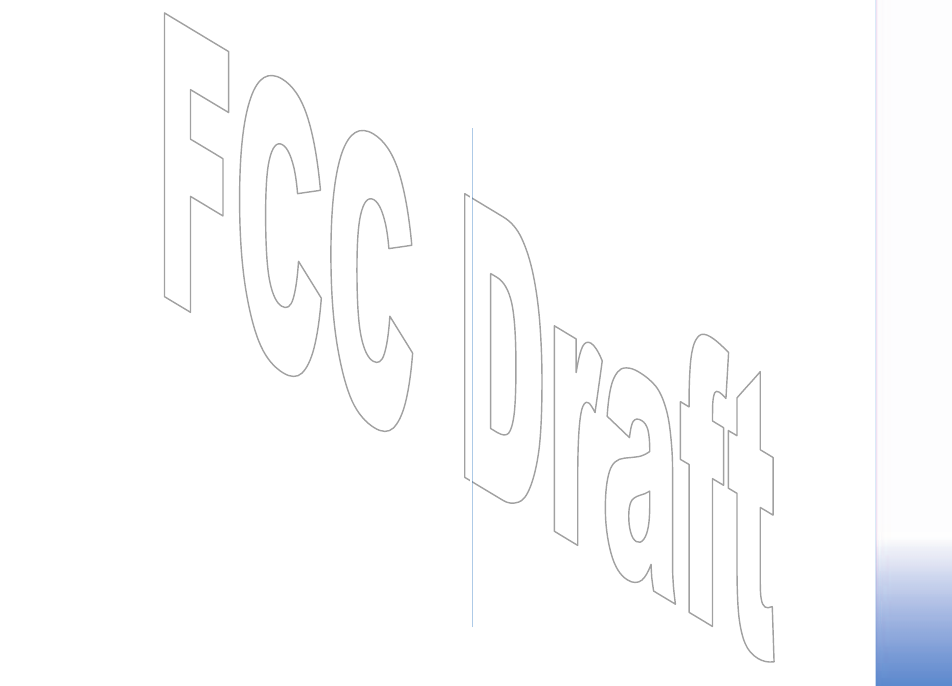
DOCUMENTTYPE 1 (1)
TypeUnitOrDepartmentHere
TypeYourNameHere TypeDateHere
Contents
For your safety...........................................8
Your Nokia N72...................................... 11
Help .........................................................................................11
Tutorial ...................................................................................11
Useful shortcuts...................................................................11
Clock........................................................................................13
Clock settings................................................................13
World clock....................................................................13
Volume and loudspeaker control ....................................14
File manager .........................................................................14
View memory consumption ......................................15
Memory low—free memory.......................................15
Memory card tool................................................................15
Format a memory card...............................................16
Personalise your device .......................... 17
Profiles—set tones...............................................................18
Offline profile................................................................18
Transfer content from another device...........................19
Change the look of your device.......................................19
Active standby mode..........................................................20
Make calls ................................................22
Calls.........................................................................................22
Make a conference call..............................................22
Speed dial a phone number......................................23
Voice dialing .................................................................23
Answer or reject a call.......................................................24
Call waiting (network service).................................24
Options during a call..................................................24
Log...........................................................................................25
Recent calls ..................................................................25
Call duration.................................................................25
Packet data ...................................................................26
Monitor all communication events........................26
Contacts (Phonebook).............................28
Save names and numbers.................................................28
Default numbers and addresses ..............................28
Copy contacts.......................................................................29
SIM directory and other SIM services ...................29
Add ringing tones for contacts .......................................30
Create contact groups .......................................................30
Remove members from a group..............................30
R1140_en.book Page 3 Thursday, March 23, 2006 9:52 AM

DOCUMENTTYPE 1 (1)
TypeUnitOrDepartmentHere
TypeYourNameHere TypeDateHere
Camera and Gallery .................................31
Camera................................................................................... 31
Take pictures................................................................. 31
Take pictures in a sequence ..................................... 32
You in the picture—self-timer ................................. 33
The flash......................................................................... 33
Adjust still image camera settings......................... 33
Adjust color and lighting .......................................... 34
Shooting modes........................................................... 34
Edit images.................................................................... 35
Record videos ............................................................... 36
Edit video clips............................................................. 37
Gallery .................................................................................... 39
View images and video clips.................................... 40
Slide show ..................................................................... 41
Albums............................................................................ 41
PrintOnline .................................................................... 42
Online sharing.............................................................. 43
Imaging.....................................................46
Image print ...........................................................................46
Printer selection........................................................... 46
Print preview ................................................................ 46
Print settings ................................................................ 46
RealPlayer.............................................................................. 47
Play video or sound clips........................................... 47
Create a track list........................................................47
Stream content over the air.....................................48
Receive RealPlayer settings...................................... 48
Movie director......................................................................49
Create a quick muvee.................................................49
Create a custom muvee.............................................49
Messaging.................................................51
Write text..............................................................................52
Traditional text input.................................................52
Predictive text input—Dictionary............................52
Copy text to clipboard ............................................... 54
Write and send messages ................................................. 54
Receive MMS and e-mail settings .........................56
Inbox—receive messages...................................................56
Multimedia messages................................................. 56
Data and settings ........................................................57
Web service messages................................................58
My folders ............................................................................ 58
Mailbox .................................................................................. 58
Open the mailbox........................................................ 58
Retrieve e-mail messages .........................................58
Delete e-mail messages.............................................59
Disconnect from the mailbox .................................. 60
Outbox—messages waiting to be sent..........................60
R1140_en.book Page 4 Thursday, March 23, 2006 9:52 AM

DOCUMENTTYPE 1 (1)
TypeUnitOrDepartmentHere
TypeYourNameHere TypeDateHere
View messages on a SIM card .........................................61
Messaging settings .............................................................61
Text messages...............................................................61
Multimedia messages.................................................62
E-mail..............................................................................63
Web service messages................................................65
Cell broadcast...............................................................65
Other settings...............................................................65
Radio ........................................................ 66
Listen to the radio...............................................................66
View visual content ............................................................67
Saved stations ......................................................................67
Settings ..................................................................................67
Calendar................................................... 69
Create calendar entries......................................................69
Set a calendar alarm...................................................70
Calendar views .....................................................................70
Delete calendar entries......................................................70
Calendar settings.................................................................70
Web.......................................................... 71
Access the Web....................................................................71
Receive browser settings...........................................71
Enter the settings manually .....................................71
Bookmarks view...................................................................72
Add bookmarks manually..........................................72
Send bookmarks...........................................................72
Make a connection.............................................................72
Connection security....................................................73
Browse....................................................................................73
View saved pages ........................................................74
Download and purchase items........................................74
End a connection.................................................................75
Empty the cache..........................................................75
Web settings.........................................................................75
My own.....................................................77
Games.....................................................................................77
Music player .........................................................................77
Play music......................................................................77
Playlists ..........................................................................78
Go to—add shortcuts..........................................................78
Delete a shortcut.........................................................78
IM—instant messaging (chat)..........................................78
Receive IM settings.....................................................79
Connect to an IM server............................................79
Modify your IM settings............................................79
Search for IM groups and users ..............................80
Join and leave an IM group......................................80
Chat.................................................................................80
R1140_en.book Page 5 Thursday, March 23, 2006 9:52 AM

DOCUMENTTYPE 1 (1)
TypeUnitOrDepartmentHere
TypeYourNameHere TypeDateHere
View and start conversations .................................. 81
IM contacts................................................................... 81
Manage IM groups......................................................81
Chat server settings.................................................... 81
Connectivity .............................................83
Bluetooth connectivity...................................................... 83
Bluetooth connectivity settings.............................. 84
Send data using Bluetooth connectivity .............. 84
Pair devices ................................................................... 85
Receive data using Bluetooth connectivity......... 86
Switch off Bluetooth connectivity......................... 86
PC connections.................................................................... 86
CD-ROM......................................................................... 86
Your device as a modem ........................................... 86
Connection manager.......................................................... 87
View data connection details .................................. 87
Remote synchronisation ...................................................88
Create a new synchronisation profile ................... 88
Synchronise data......................................................... 89
Device manager................................................................... 89
Server profile settings................................................ 90
Office........................................................91
Calculator.............................................................................. 91
Converter............................................................................... 91
Set base currency and exchange rates..................92
To-do ...................................................................................... 92
Notes ...................................................................................... 92
Recorder................................................................................. 93
Tools..........................................................94
Settings.................................................................................. 94
Phone settings..............................................................94
Call settings ..................................................................95
Connection settings....................................................96
Date and time............................................................... 98
Security .......................................................................... 99
Call diverting ..............................................................101
Call barring..................................................................102
Network........................................................................102
Enhancement settings .............................................102
Voice commands ...............................................................103
Application manager........................................................103
Install applications and software .........................104
Remove applications and software......................105
Application settings..................................................105
Activation keys—handle copyright-protected files .105
Troubleshooting .................................... 107
Q&A.......................................................................................107
R1140_en.book Page 6 Thursday, March 23, 2006 9:52 AM
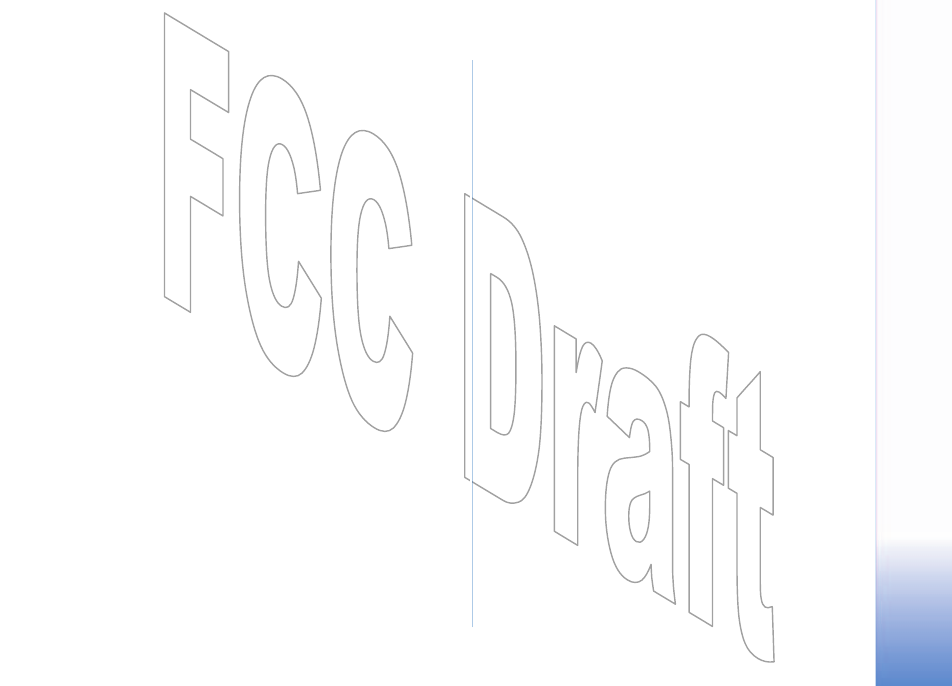
DOCUMENTTYPE 1 (1)
TypeUnitOrDepartmentHere
TypeYourNameHere TypeDateHere
Battery information.............................. 110
Charging and discharging.............................................. 110
Nokia battery authentication guidelines................... 110
Care and maintenance ......................... 113
Additional safety information............. 114
R1140_en.book Page 7 Thursday, March 23, 2006 9:52 AM
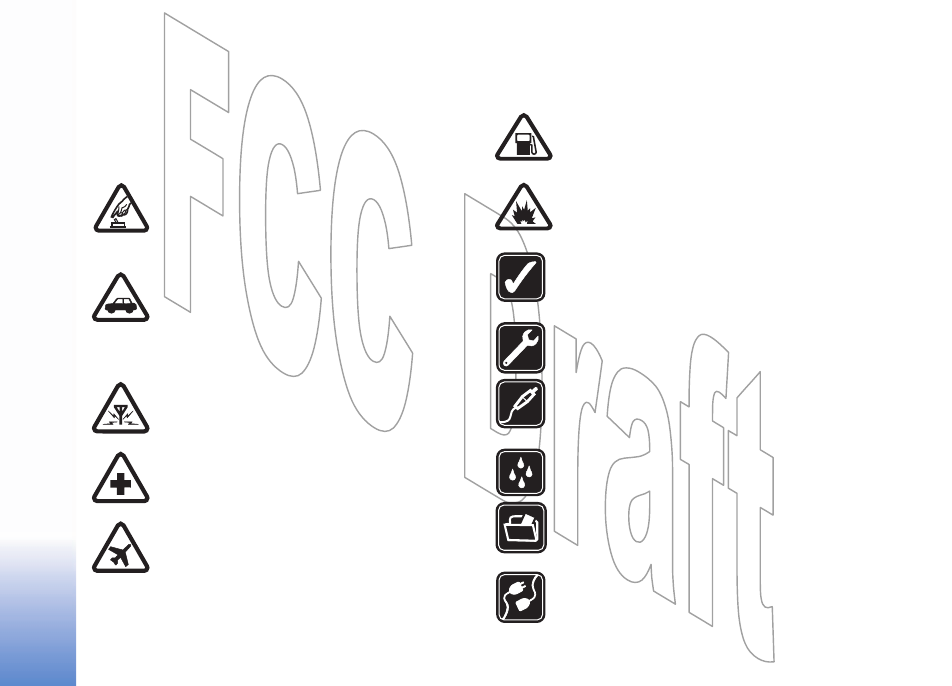
DOCUMENTTYPE 1 (1)
TypeUnitOrDepartmentHere
TypeYourNameHere TypeDateHere
8
For your safety
Read these simple guidelines. Not following them may be
dangerous or illegal. Read the complete user guide for
further information.
SWITCH ON SAFELY Do not switch the
device on when wireless phone use is
prohibited or when it may cause interference
or danger.
ROAD SAFETY COMES FIRST Obey all local
laws. Always keep your hands free to operate
the vehicle while driving. Your first
consideration while driving should be road
safety.
INTERFERENCE All wireless devices may be
susceptible to interference, which could affect
performance.
SWITCH OFF IN HOSPITALS Follow any
restrictions. Switch the device off near
medical equipment.
SWITCH OFF IN AIRCRAFT Follow any
restrictions. Wireless devices can cause
interference in aircraft.
SWITCH OFF WHEN REFUELING Do not use
the device at a refueling point. Do not use near
fuel or chemicals.
SWITCH OFF NEAR BLASTING Follow any
restrictions. Do not use the device where
blasting is in progress.
USE SENSIBLY Use only in the normal position
as explained in the product documentation. Do
not touch the antenna unnecessarily.
QUALIFIED SERVICE Only qualified personnel
may install or repair this product.
ENHANCEMENTS AND BATTERIES Use only
approved enhancements and batteries. Do not
connect incompatible products.
WATER-RESISTANCE Your device is not
water-resistant. Keep it dry.
BACK-UP COPIES Remember to make back-up
copies or keep a written record of all important
information.
CONNECTING TO OTHER DEVICES When
connecting to any other device, read its user
R1140_en.book Page 8 Thursday, March 23, 2006 9:52 AM
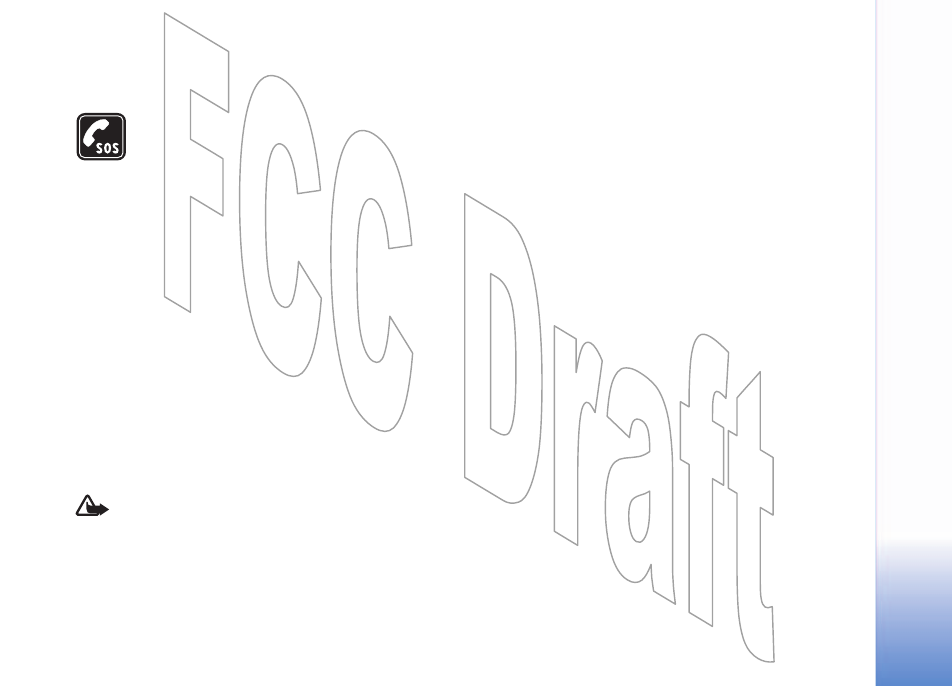
DOCUMENTTYPE 1 (1)
TypeUnitOrDepartmentHere
TypeYourNameHere TypeDateHere
9
guide for detailed safety instructions. Do not
connect incompatible products.
EMERGENCY CALLS Ensure the phone
function of the device is switched on and in
service. Press the end key as many times as
needed to clear the display and return to the
start screen. Enter the emergency number,
then press the call key. Give your location. Do
not end the call until given permission to do so.
About your device
The wireless device described in this guide is approved for
use on the EGSM 900/1800/1900 networks. Contact your
service provider for more information about networks.
When using the features in this device, obey all laws, and
respect privacy and legitimate rights of others.
When taking and using images or video clips, obey all laws,
and respect local customs as well as privacy and legitimate
rights of others.
Warning: To use any features in this device, other
than the alarm clock, the device must be switched on.
Do not switch the device on when wireless device use
may cause interference or danger.
Network services
To use the phone you must have service from a wireless
service provider. Many of the features in this device
depend on features in the wireless network to function.
These network services may not be available on all
networks or you may have to make specific arrangements
with your service provider before you can utilize network
services. Your service provider may need to give you
additional instructions for their use and explain what
charges will apply. Some networks may have limitations
that affect how you can use network services. For
instance, some networks may not support all
language-dependent characters and services.
Your service provider may have requested that certain
features be disabled or not activated in your device. If so,
they will not appear on your device menu. Your device may
also have been specially configured. This configuration
may include changes in menu names, menu order, and
icons. Contact your service provider for more information.
This device supports WAP 2.0 protocols (HTTP and SSL)
that run on TCP/IP protocols. Some features of this device,
such as MMS, browsing, e-mail and content downloading
using the browser or over MMS, require network support
for these technologies.
R1140_en.book Page 9 Thursday, March 23, 2006 9:52 AM

DOCUMENTTYPE 1 (1)
TypeUnitOrDepartmentHere
TypeYourNameHere TypeDateHere
10
For availability and information on using SIM card
services, contact your SIM card vendor. This may be the
service provider, network operator, or other vendor.
Enhancements, batteries, and
chargers
Always switch the device off, and disconnect the charger
before removing the battery.
Check the model number of any charger before use with
this device. This device is intended for use when supplied
with power from a DC-4, AC-3, and AC-4 charger, and
from an AC-1, ACP-8, ACP-9, ACP-12, LCH-8, LCH-9, or
LCH-12 charger when used with the CA-44 charger
adapter delivered with your device.
The battery intended for use with this device is BL-5C.
Warning: Use only batteries, chargers, and
enhancements approved by Nokia for use with this
particular model. The use of any other types may
invalidate any approval or warranty and may be
dangerous.
For availability of approved enhancements, please check
with your dealer. When you disconnect the power cord of
any enhancement, grasp and pull the plug, not the cord.
R1140_en.book Page 10 Thursday, March 23, 2006 9:52 AM

DOCUMENTTYPE 1 (1)
TypeUnitOrDepartmentHere
TypeYourNameHere TypeDateHere
Your Nokia N72
11
Your Nokia N72
Model number: Nokia N72-5
Hereinafter referred to as Nokia N72.
Help
Your device has context-sensitive help. You can access the
help from an application or from the main menu.
When an application is open, to access help for the current
view, select Options > Help.
Example: To view instructions on how to create a
contact card, start to create a contact card, and select
Options > Help.
When you are reading the instructions, to switch between
help and the application that is open in the background,
press and hold .
To open help from the main menu, select Tools > Help.
Select the desired application to view a list of help topics.
To search for help topics using keywords, select Options >
Search by keyword.
When you are reading a help topic, to view other related
topics, press or .
Tutorial
The tutorial gives you information about some of the
features of your device.
To access the tutorial in the menu, press , and select My
own > Tutorial and the section you want to view. To
ensure you have access to all Tutorial contents, insert the
compatible memory card supplied with your device into
the device.
Useful shortcuts
Use shortcuts to quickly get the most from your device.
Refer to the relevant sections in this user guide for further
details of the functions.
Take pictures
• To adjust image setup settings before taking a picture,
press .
• After taking a picture, to send the image Via
multimedia, Via e-mail, or Via Bluetooth, press .
For more information, see ‘Messaging’, p. 51 and
‘Bluetooth connectivity’, p. 83.
R1140_en.book Page 11 Thursday, March 23, 2006 9:52 AM

DOCUMENTTYPE 1 (1)
TypeUnitOrDepartmentHere
TypeYourNameHere TypeDateHere
Your Nokia N72
12
• To delete an image, press .
• To take a new picture, press or the camera capture
key.
Record video clips
• To adjust video setup settings before recording video,
press .
• After recording a video clip, to send the video Via
multimedia, Via e-mail, or Via Bluetooth, press .
You cannot send video clips saved in the .mp4 format
in a multimedia message. For more information, see
‘Messaging’, p. 51 and ‘Bluetooth connectivity’, p. 83.
• To delete a video clip, press .
Edit text and lists
• To mark an item in a list, scroll to it, and press and
at the same time.
• To mark multiple items in a list, press and hold
while you press or . To end the selection, release
, then release .
• To copy and paste text: To select letters and words,
press and hold . At the same time, press or .
As the selection moves, text is highlighted. To copy the
text to clipboard, while still holding , select Copy.
To insert the text into a document, press and hold ,
and select Paste.
Standby mode
• To switch between applications that are open, press
and hold . If memory is low, the device may close
some applications. The device saves any unsaved data
before closing an application.
Leaving applications running in the background
increases the demand on battery power and reduces
the battery life.
• To change the profile, press , and select a profile.
• To switch between General and Silent profiles, press
and hold . If you have two phone lines, this action
switches between the two lines.
• To open the last dialled numbers list, press .
• To use voice commands, press and hold .
• To start a connection to Web, press and hold . See
‘Web’, p. 71.
For further shortcuts available in the standby mode, see
‘Active standby mode’, p. 20.
Keypad lock (keyguard)
• To lock: In the standby mode, press , then .
• To unlock: Press , then .
• To turn on the display light when the keypad lock is on,
press .
When the keypad lock is on, calls may be possible to the
official emergency number programmed into your device.
R1140_en.book Page 12 Thursday, March 23, 2006 9:52 AM
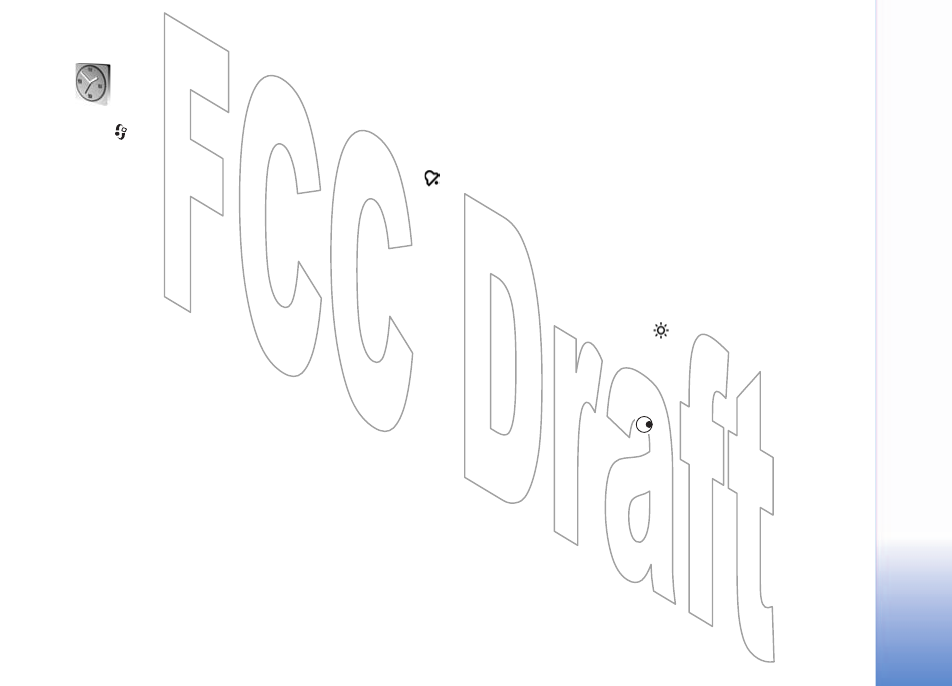
DOCUMENTTYPE 1 (1)
TypeUnitOrDepartmentHere
TypeYourNameHere TypeDateHere
Your Nokia N72
13
Clock
Press , and select Clock.
To set a new alarm, select Options > Set alarm. Enter the
alarm time, and select OK. When the alarm is active, is
shown.
To turn off the alarm, select Stop. When the alarm tone
sounds, select Snooze to stop the alarm for five minutes,
after which it resumes. You can do this a maximum of five
times.
If the alarm time is reached while the device is switched
off, the device switches itself on and starts sounding the
alarm tone. If you select Stop, the device asks whether you
want to activate the device for calls. Select No to switch
off the device or Yes to make and receive calls. Do not
select Yes when wireless phone use may cause
interference or danger.
To cancel an alarm, select Clock > Options > Remove
alarm.
Clock settings
To change the clock settings, select Options > Settings in
the clock. To change the time or date, select Time or Date.
To change the clock shown in the standby mode, scroll
down, and select Clock type > Analogue or Digital.
To allow the mobile phone network to update the time,
date, and time zone information to your device (network
service), scroll down, and select Auto time update. For the
Auto time update setting to take effect, the device
restarts.
To change the alarm tone, scroll down, and select Clock
alarm tone.
To change the daylight-saving time status, scroll down,
and select Daylight-saving. Select On to add 1 hour to the
My current city time. See ‘World clock’, p. 13. When the
daylight-saving is active, is shown in the clock main
view. This setting is not shown if Auto time update is on.
World clock
Open Clock, and press to open the world clock view.
In the world clock view, you can view the time in different
cities.
To add cities to the list, select Options > Add city. Enter
the first letters of the city name. The search field appears
automatically, and the matching cities are displayed.
Select a city. You can add a maximum of 15 cities to the
list.
R1140_en.book Page 13 Thursday, March 23, 2006 9:52 AM

DOCUMENTTYPE 1 (1)
TypeUnitOrDepartmentHere
TypeYourNameHere TypeDateHere
Your Nokia N72
14
To set your current city, scroll to a city, and select
Options > My current city. The city is displayed in the
clock main view, and the time in your device is changed
according to the city selected. Check that the time is
correct and matches your time zone.
Volume and loudspeaker control
To increase or decrease the
volume level when you have
an active call or are listening
to a sound, press or .
The built-in loudspeaker allows you to speak and listen
from a short distance without having to hold the device
to your ear. Sound applications use the loudspeaker by
default.
Warning: Do not hold the device near your ear
when the loudspeaker is in use, because the volume
may be extremely loud.
To use the loudspeaker during a call, start a call, and select
Options > Activate loudsp..
To turn off the loudspeaker when you have an active call
or are listening to a sound, select Options > Activate
handset.
File manager
Many features of the device use memory to store data.
These features include contacts, messages, images, ringing
tones, calendar and to-do notes, documents, and
downloaded applications. The free memory available
depends on how much data is already saved in the device
memory. You can use a compatible memory card as extra
storage space. Memory cards are rewritable, so you can
delete and save data on a memory card.
To browse files and folders in the device memory or on a
memory card (if inserted), press , and select Tools > File
mgr.. The device memory view ( ) opens. Press to
open the memory card view ( ).
To move or copy files to a folder, press and at the
same time to mark a file, and select Options > Move to
folder or Copy to folder.
To find a file, select Options > Find and the memory from
which to search, and enter a search text that matches the
file name.
Tip! You can use Nokia Phone Browser available in
Nokia PC Suite to view the different memories in your
device. See the CD-ROM supplied with your device.
R1140_en.book Page 14 Thursday, March 23, 2006 9:52 AM

DOCUMENTTYPE 1 (1)
TypeUnitOrDepartmentHere
TypeYourNameHere TypeDateHere
Your Nokia N72
15
View memory consumption
To view what types of data you have in the device and how
much memory the different data types consume, select
Options > Memory details. Scroll down to Free memory
to view the amount of free memory in the device.
To view the amount of free memory on the memory card,
if you have a card inserted in the device, press to open
the memory card view, and select Options > Memory
details.
Memory low—free memory
The device notifies you if the device memory or memory
card memory is getting low.
To free device memory, transfer data to a memory card in
the file manager. Mark files to be moved, select Options >
Move to folder > Memory card, and a folder.
Tip! To free memory from the device or from the
memory card, use Image Store available in Nokia PC
Suite to transfer images and video clips to a compatible
PC. See the CD-ROM supplied with your device.
To remove data to free memory, use File mgr., or go to the
respective application. For example, you can remove the
following:
• Messages from Inbox, Drafts, and Sent folders in
Messaging
• Retrieved e-mail messages from the device memory
• Saved Web pages
• Saved images, videos, or sound files
• Contact information
•Calendar notes
• Downloaded applications. See also ‘Application
manager’, p. 103.
• Any other data that you no longer need
Memory card tool
Note: This device uses a Reduced Size Dual Voltage
(1.8 or 3V) MultiMediaCard (RS-MMC). To ensure
interoperability, use only dual voltage RS-MMCs. Check
the compatibility of an RS-MMC with its manufacturer or
provider.
Use only Reduced Size MultiMediaCards (RS-MMC)
approved by Nokia for use with this device. Nokia utilizes
the approved industry standards for memory cards but not
all other brands may function correctly or be fully
compatible with this device.
Keep all memory cards out of the reach of small children.
R1140_en.book Page 15 Thursday, March 23, 2006 9:52 AM

DOCUMENTTYPE 1 (1)
TypeUnitOrDepartmentHere
TypeYourNameHere TypeDateHere
Your Nokia N72
16
Press , and select Tools >
Memory. You can use a
memory card as extra
storage space. It is also good
to regularly back up the
information in the device
memory to the memory card.
The information can be
restored to the device later.
You cannot use the memory
card if the door of the
memory card slot is open.
Important: Do not remove the memory card in the
middle of an operation when the card is being accessed.
Removing the card in the middle of an operation may
damage the memory card as well as the device, and data
stored on the card may be corrupted.
To back up information from device memory to a memory
card, select Options > Backup phone mem.
To restore information from the memory card to the
device memory, select Options > Restore from card.
Tip! To rename a memory card, select Options >
Memory card name.
Format a memory card
When a memory card is reformatted, all data on the card
is permanently lost.
Some memory cards are supplied preformatted and others
require formatting. Consult your retailer to find out if you
must format the memory card before you can use it.
To format a memory card, select Options > Format mem.
card. Select Yes to confirm. When formatting is complete,
enter a name for the memory card, and select OK.
R1140_en.book Page 16 Thursday, March 23, 2006 9:52 AM

DOCUMENTTYPE 1 (1)
TypeUnitOrDepartmentHere
TypeYourNameHere TypeDateHere
Personalise your device
17
Personalise your device
Your service provider may have requested that certain
features be disabled or not activated in your device. If so,
they will not appear on your device menu. Your device may
also have been specially configured for your network
provider. This configuration may include changes in menu
names, menu order, and icons. Contact your service
provider for more information.
• To use the standby display for fast access to your most
frequently used applications, see ‘Active standby
mode’, p. 20.
• To change the standby
mode background image
or what is shown in the
power saver, see ‘Change
the look of your device’,
p. 19.
• To customise the ringing
tones, see ‘Profiles—set
tones’, p. 18.
• To change the shortcuts
assigned for the different
presses of the scroll key
and left and right selection keys in the standby mode,
see ‘Standby mode’, p. 94. The scroll key shortcuts are
not available if the active standby is on.
• To change the clock shown in the standby mode, press
, and select Clock > Options > Settings > Clock
type > Analogue or Digital.
• To change the clock alarm tone, press , and select
Clock > Options > Settings > Clock Alarm tone and
a tone.
• To change the calendar alarm tone, press , and
select Calendar > Options > Settings > Calendar
alarm tone and a tone.
• To change the welcome note to a text or an image,
press , and select Tools > Settings > Phone >
General > Welcome note or logo.
• To assign an individual ringing tone to a contact, press
, and select Contacts. See ‘Add ringing tones for
contacts’, p. 30.
• To assign a speed dial to a contact, press a number key
in the standby mode ( is reserved for the voice
mailbox), and press . Select Yes, then select a
contact.
• To rearrange the main menu, in the main menu, select
Options > Move, Move to folder, or New folder. You
can move less used applications into folders, and place
applications that you use more often into the main
menu.
R1140_en.book Page 17 Thursday, March 23, 2006 9:52 AM

DOCUMENTTYPE 1 (1)
TypeUnitOrDepartmentHere
TypeYourNameHere TypeDateHere
Personalise your device
18
Profiles—set tones
To set and customise the ringing tones, message alert
tones, and other tones for different events, environments,
or caller groups, press , and select Tools > Profiles. If
the currently selected profile is other than General, the
profile name is shown at the top of the display in the
standby mode.
To change the profile, press in the standby mode.
Scroll to the profile you want to activate, and select OK.
To modify a profile, press , and select Tools > Profiles.
Scroll to the profile, and select Options > Personalise.
Scroll to the setting you want to change, and press to
open the choices. Tones stored on the memory card are
indicated with . You can scroll through the tone list
and listen to each one before you make your selection.
Press any key to stop the sound.
Tip! In the list of tones, Tone downloads opens a list
of bookmarks. You can select a bookmark and start
connection to a Web page to download tones.
To create a new profile, select Options > Create new.
Offline profile
The Offline profile lets you use the device without
connecting to the wireless network. When you activate the
Offline profile, the connection to the wireless network is
turned off, as indicated by in the signal strength
indicator area. All wireless phone signals to and from the
device are prevented. If you try to send messages, they are
placed in the outbox to be sent later.
Warning: In the offline profile you cannot make or
receive any calls, except make calls to certain
emergency numbers, or use other features that require
network coverage. To make calls, you must first activate
the phone function by changing profiles. If the device
has been locked, enter the lock code.
Warning: Your device must be switched on to use
Offline profile. Do not switch the device on when
wireless device use is prohibited or when it may cause
interference or danger.
To leave the Offline profile, press , and select another
profile. The device re-enables wireless transmissions
(providing there is sufficient signal strength). If Bluetooth
connectivity is activated before entering the Offline
profile, it will be deactivated. Bluetooth connectivity is
automatically reactivated after leaving the Offline profile.
See ‘Bluetooth connectivity settings’, p. 84.
R1140_en.book Page 18 Thursday, March 23, 2006 9:52 AM
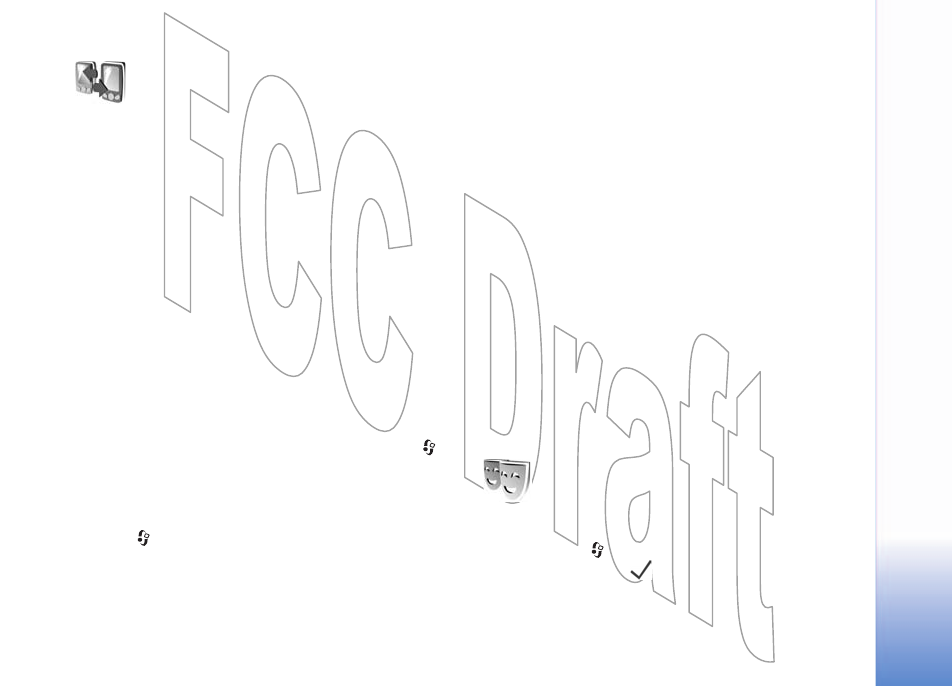
DOCUMENTTYPE 1 (1)
TypeUnitOrDepartmentHere
TypeYourNameHere TypeDateHere
Personalise your device
19
Transfer content from
another device
You can copy contacts, calendar, images, video, and sound
clips using Bluetooth connectivity, from a compatible
Nokia Series 60 device.
Copyright protections may prevent some images, music
(including ringing tones), and other content from being
copied, modified, transferred or forwarded.
You can use your Nokia N72 without a SIM card. The
offline profile is automatically activated when the device
is switched on without a SIM card. This allows you to use
the SIM card in another device.
To avoid duplicate entries, you can transfer the same type
of information (for example, contacts) from the other
device to your Nokia N72 only once.
Before starting the transfer, you must activate Bluetooth
connectivity on both devices. On each device, press ,
and select Connect. > Bluetooth. Select Bluetooth > On.
Give a name to each device.
To transfer content:
1Press , and select Tools > Transfer on your Nokia
N72. Follow the instructions on the screen.
2The device searches for other devices with Bluetooth
connectivity. When it has finished the search, select
your other device from the list.
3You are asked to enter a code on your Nokia N72. Enter
a code (1-16 digits), and select OK. Enter the same
code on the other device, and select OK.
4The Transfer application is sent to the other device as
a message.
5Open the message to install Transfer on the other
device, and follow the instructions on the screen.
6From your Nokia N72, select the content you want to
copy from the other device.
Content is copied from the memory and memory card of
the other device to your Nokia N72 and memory card.
Copying time depends on the amount of data to be
transferred. You can cancel copying and continue later.
The Transfer application is added to the main menu of the
other device.
Change the look of your
device
To change the look of the display, such as the wallpaper
and icons, press , and select Tools > Themes. The active
theme is indicated by . In Themes you can group
together elements from other themes or select images
from the Gallery to personalise themes further. The
R1140_en.book Page 19 Thursday, March 23, 2006 9:52 AM

DOCUMENTTYPE 1 (1)
TypeUnitOrDepartmentHere
TypeYourNameHere TypeDateHere
Personalise your device
20
themes on the memory card are indicated by . The
themes on the memory card are not available if the
memory card is not inserted in the device. If you want to
use the themes saved in the memory card without the
memory card, save the themes in the device memory first.
To open a browser connection and download more
themes, select Theme downloads.
To activate a theme, scroll to it, and select Options >
Apply.
To preview a theme, scroll to it, and select Options >
Preview.
To edit themes, scroll to a theme, and select Options >
Edit to change the following options:
Wallpaper—The image to be shown as a background
image in the standby mode.
Power saver—The power saver type on the display: date
and time, or a text you have written yourself. See also
‘Display’, p. 95.
Image in 'Go to'—The background image for the Go to
application.
To restore the selected theme back to its original settings,
select Options > Restore orig. theme when you edit a
theme.
Active standby mode
Use your standby display for fast access to your most
frequently used applications. By default, the active
standby mode is on.
Press , select Tools > Settings > Phone > Standby
mode > Active standby, and press to switch the active
standby on or off.
The active standby display is
shown with default
applications across the top of
the screen.
Scroll to an application or
event, and press .
The standard scroll key
shortcuts available in the
standby mode cannot be used
when the active standby
mode is on.
To change the default applications shortcuts:
1Press , select Tools > Settings > Phone > Standby
mode > Active standby apps., and press .
2Highlight a shortcut to an application, and select
Options > Change.
3Select a new application from the list, and press .
R1140_en.book Page 20 Thursday, March 23, 2006 9:52 AM
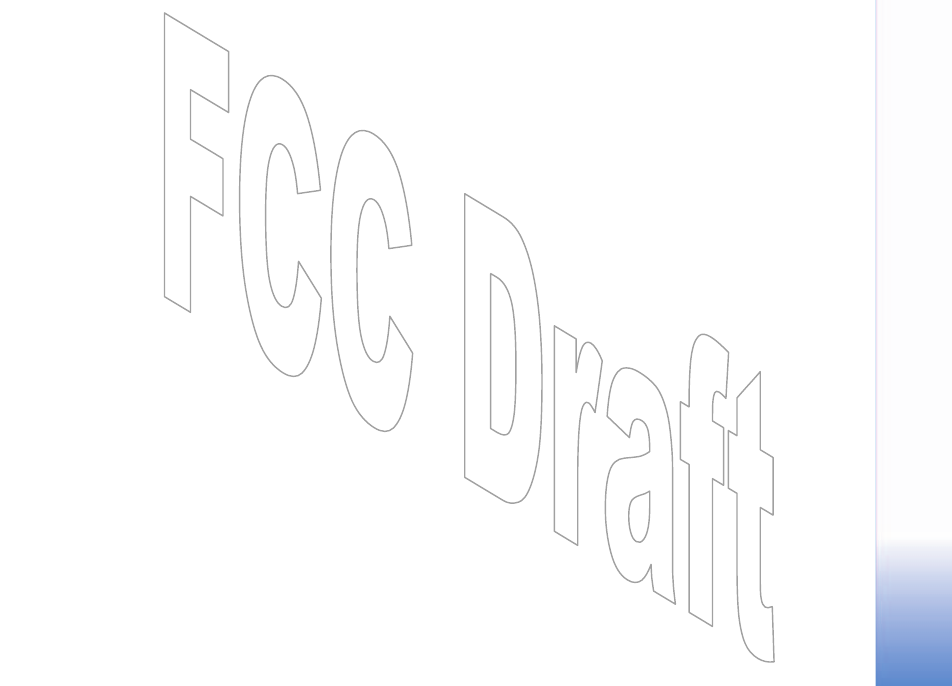
DOCUMENTTYPE 1 (1)
TypeUnitOrDepartmentHere
TypeYourNameHere TypeDateHere
Personalise your device
21
Some shortcuts may be fixed, and you are not able to
change them.
R1140_en.book Page 21 Thursday, March 23, 2006 9:52 AM

DOCUMENTTYPE 1 (1)
TypeUnitOrDepartmentHere
TypeYourNameHere TypeDateHere
Make calls
22
Make calls
Calls
Tip! To increase or decrease the volume during a
call, press or . If you have set the volume to
Mute, you cannot adjust the volume with the scroll
key. To adjust the volume, select Unmute, and press
or .
1In the standby mode, enter the phone number,
including the area code. Press to remove a
number.
For international calls, press twice for the +
character (replaces the international access code), and
enter the country code, area code (omit the leading
zero if necessary), and phone number.
2Press to call the number.
3Press to end the call (or to cancel the call
attempt).
Pressing always ends a call, even if another
application is active.
To make a call from Contacts, press , and select
Contacts. Scroll to the desired name; or enter the first
letters of the name to the search field. Matching contacts
are listed. Press to call. Select the call type Voice call.
You must copy the contacts from your SIM card to
Contacts before you can make a call this way. See ‘Copy
contacts’, p. 29.
To call your voice mailbox (network service), press and hold
in the standby mode. See also ‘Call diverting’, p. 101.
Tip! To change the phone number of your voice
mailbox, press , and select Tools > Voice mail >
Options > Change number. Enter the number
(obtained from your service provider), and select OK.
To call a recently dialed number in the standby mode, press
to access a list of the 20 last numbers you called or
attempted to call. Scroll to the number you want, and press
to call the number.
Make a conference call
1Make a call to the first participant.
2To make a call to another participant, select Options >
New call. The first call is automatically put on hold.
3When the new call is answered, to join the first
participant in the conference call, select Options >
Conference.
To add a new person to the call, repeat step 2, and
select Options > Conference > Add to conference.
R1140_en.book Page 22 Thursday, March 23, 2006 9:52 AM

DOCUMENTTYPE 1 (1)
TypeUnitOrDepartmentHere
TypeYourNameHere TypeDateHere
Make calls
23
The device supports conference calls between a
maximum of six participants, including yourself.
To have a private conversation with one of the
participants, select Options > Conference > Private.
Select a participant, and select Private. The conference
call is put on hold on your device. The other
participants can still continue the conference call.
After you finish the private conversation, select
Options > Add to conference to return to the
conference call.
To drop a participant, select Options > Conference >
Drop participant, scroll to the participant, and select
Drop.
4To end the active conference call, press .
Speed dial a phone number
To activate speed dialing, press , and select Tools >
Settings > Call > Speed dialling > On.
To assign a phone number to one of the speed dialing keys
( — ), press , and select Tools > Speed dial. Scroll
to the key to which you want to assign the phone number,
and select Options > Assign. is reserved for the voice
mailbox.
To call in the standby mode, press the speed dial key and
.
Voice dialing
Your device supports enhanced voice commands.
Enhanced voice commands are not dependent on the
speaker’s voice, so the user does not record voice tags in
advance. Instead, the device creates a voice tag for the
entries in contacts, and compares the spoken voice tag to
it. The voice recognition in the device adapts to the main
user’s voice to recognize the voice commands better.
The voice tag for a contact is the name or nickname that
is saved on the contact card. To listen to the synthesized
voice tag, open a contact card, and select Options > Play
voice tag.
Make a call with a voice tag
Note: Using voice tags may be difficult in a noisy
environment or during an emergency, so you should
not rely solely upon voice dialing in all circumstances.
When you use voice dialing, the loudspeaker is in use. Hold
the device at a short distance away when you say the
voice tag.
1To start voice dialing, press and hold . If you are
using a compatible headset with the headset key, press
and hold the headset key to start voice dialing.
2A short tone is played, and Speak now is displayed. Say
clearly the name or nickname that is saved on the
contact card.
R1140_en.book Page 23 Thursday, March 23, 2006 9:52 AM
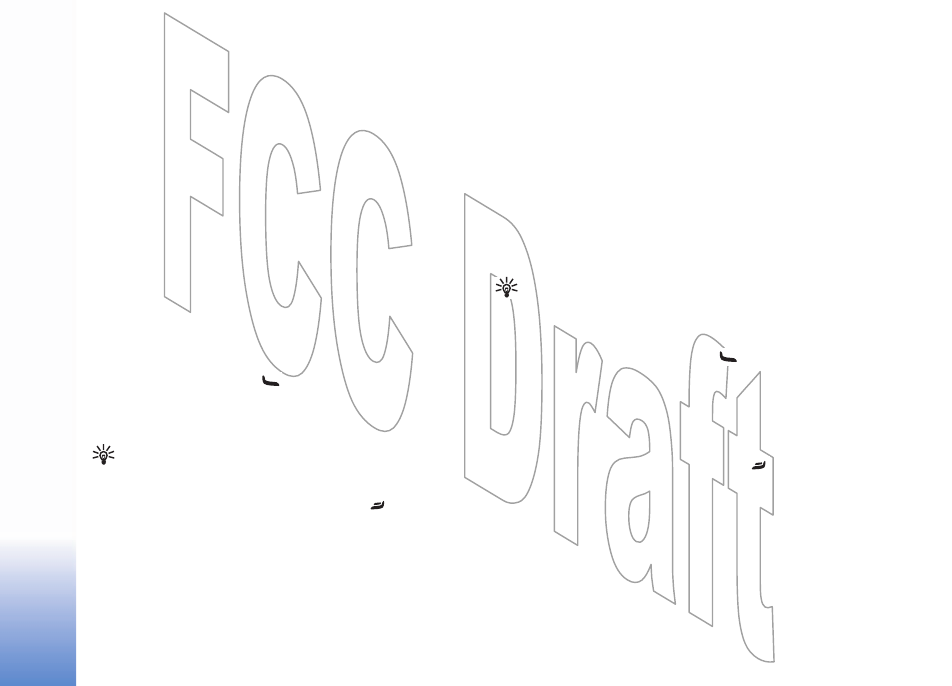
DOCUMENTTYPE 1 (1)
TypeUnitOrDepartmentHere
TypeYourNameHere TypeDateHere
Make calls
24
3The device plays a synthesized voice tag for the
recognized contact in the selected device language,
and displays the name and number. After a time-out
of 1.5 seconds, the device dials the number.
If the recognized contact was not correct, select Next
to view a list of other matches, or Quit to cancel voice
dialing.
If several numbers are saved under the name, the device
selects the default number, if it has been set. Otherwise
the device selects the first available number of the
following: Mobile, Mobile (home), Mobile (business),
Telephone, Tel. (home), and Tel. (business).
Answer or reject a call
To answer the call, press .
To mute the ringing tone when a call comes in, select
Silence.
Tip! If a compatible headset is connected to the
device, to answer and end a call, press the headset key.
If you do not want to answer a call, press to reject it.
The caller hears a line busy tone. If you have activated the
Call divert settings > Voice calls > If busy function to
divert calls, rejecting an incoming call also diverts the call.
See ‘Call diverting’, p. 101.
When you reject an incoming call, you can also send a text
message to the caller informing why you cannot answer
the call. Select Options > Send text message. You can edit
the text before sending it. See also Reject call with SMS,
p. 95.
Call waiting (network service)
You can answer a call while you have another call in
progress if you have activated Call waiting (network
service) in Tools > Settings > Call > Call waiting.
Tip! To change the device tones for different
environments and events (for example, when you want
your device to be silent), see ‘Profiles—set tones’, p. 18.
To answer the waiting call, press . The first call is put
on hold.
To switch between the two calls, select Swap. Select
Options > Transfer to connect an incoming call or a call
on hold with an active call and to disconnect yourself from
the calls. To end the active call, press . To end both
calls, select Options > End all calls.
Options during a call
Many of the options that you can use during a call are
network services. Select Options during a call for some of
the following options: Mute or Unmute, Answer, Reject,
R1140_en.book Page 24 Thursday, March 23, 2006 9:52 AM

DOCUMENTTYPE 1 (1)
TypeUnitOrDepartmentHere
TypeYourNameHere TypeDateHere
Make calls
25
Swap, Hold or Unhold, Activate handset, Activate
loudsp., or Activate handsfree (if a compatible headset
with Bluetooth connectivity is attached), End active call
or End all calls, New call, Conference, and Transfer.
Select from the following:
Replace—to end an active call and replace it by answering
the waiting call.
Send DTMF—to send DTMF tone strings (for example, a
password). Enter the DTMF string or search for it in
Contacts. To enter a wait character (w) or a pause
character (p), press repeatedly. Select OK to send the
tone.
Tip! You can add DTMF tones to the Phone number
or DTMF fields in a contact card.
Log
Recent calls
To monitor the phone numbers of missed, received, and
dialed calls, press , and select My own > Log > Recent
calls. The device registers missed and received calls only if
the network supports these functions, the device is
switched on, and within the network service area.
Tip! When you see a note in the standby mode about
missed calls, select Show to access the list of missed
calls. To call back, scroll to a name or number, and
press .
To clear all recent call lists, select Options > Clear recent
calls in the recent calls main view. To clear one of the call
registers, open the register you want to erase, and select
Options > Clear list. To clear an individual event, open a
register, scroll to the event, and press .
Call duration
To monitor the approximate duration of your incoming
and outgoing calls, press , and select My own > Log >
Call duration.
Note: The actual time invoiced for calls by your
service provider may vary, depending on network
features, rounding off for billing, and so forth.
To clear call duration timers, select Options > Clear
timers. For this you need the lock code. See ‘Security’,
‘Phone and SIM’, p. 99.
R1140_en.book Page 25 Thursday, March 23, 2006 9:52 AM

DOCUMENTTYPE 1 (1)
TypeUnitOrDepartmentHere
TypeYourNameHere TypeDateHere
Make calls
26
Packet data
To check the amount of data sent and received during
packet data connections, press , and select My own >
Log > Packet data. For example, you may be charged for
your packet data connections by the amount of data sent
and received.
Monitor all communication events
Icons in Log:
Incoming
Outgoing
Missed communication events
To monitor all voice and video
calls, text messages, or data
connections registered by the
device, press , select My
own > Log, and press the
scroll key to the right to open
the general log. For each
communication event, you can
see the sender or recipient
name, phone number, name of
the service provider, or access
point. You can filter the general log to view just one type
of event and create new contact cards based on the log
information.
Tip! If you want to see the duration of a voice call on
the main display during an active call, select Options >
Settings > Show call duration > Yes.
Tip! To view a list of sent messages, press , and
select Messaging > Sent.
Subevents, such as a text message sent in more than one
part and packet data connections, are logged as one
communication event. Connections to your mailbox,
multimedia messaging center, or Web pages are shown as
packet data connections.
To filter the log, select Options > Filter and a filter.
To erase the contents of the log, recent calls register, and
messaging delivery reports permanently, select Options >
Clear log. Select Yes to confirm.
To set the Log duration, select Options > Settings > Log
duration. The log events remain in the device memory for
a set number of days after which they are automatically
erased to free memory. If you select No log, all the log
contents, recent calls register, and messaging delivery
reports are permanently deleted.
To view the details of a communication event, in the
general log view scroll to an event, and press the scroll key.
Tip! In the details view you can copy a phone number
to the clipboard, and paste it to a text message, for
example. Select Options > Copy Number.
R1140_en.book Page 26 Thursday, March 23, 2006 9:52 AM

DOCUMENTTYPE 1 (1)
TypeUnitOrDepartmentHere
TypeYourNameHere TypeDateHere
Make calls
27
Packet data counter and connection timer: To view how
much data, measured in kilobytes, is transferred and how
long a certain packet data connection lasts, scroll to an
incoming or outgoing event indicated by Pack., and select
Options > View details.
R1140_en.book Page 27 Thursday, March 23, 2006 9:52 AM

DOCUMENTTYPE 1 (1)
TypeUnitOrDepartmentHere
TypeYourNameHere TypeDateHere
Contacts (Phonebook)
28
Contacts (Phonebook)
Press , and select Contacts. In Contacts you can add a
personal ringing tone or a thumbnail image to a contact
card. You can also create contact groups, which allow you
to send text messages or e-mail to many recipients at the
same time. You can add received contact information
(business cards) to contacts. See ‘Data and settings’, p. 57.
Contact information can only be sent to or received from
compatible devices.
Tip! Regularly back up the information on the device
to the memory card. You can restore the information,
such as contacts, to the device later. See ‘Memory card
tool’, p. 15. You can also use Nokia PC Suite to back up
your contacts to a compatible PC. See the CD-ROM
supplied with your device.
Save names and numbers
1Select Options > New contact.
2Fill in the fields that you want, and select Done.
To edit contact cards in Contacts, scroll to the contact
card you want to edit, and select Options > Edit.
To delete a contact card in Contacts, select a card, and
press . To delete several contact cards at the same time,
press and to mark the contacts, and press to
delete.
Tip! To add and edit contact cards, use Nokia Contacts
Editor available in Nokia PC Suite. See the CD-ROM
supplied with your device.
To attach a small thumbnail image to a contact card, open
the contact card, and select Options > Edit > Options >
Add thumbnail. The thumbnail image is shown when the
contact calls.
Tip! To send contact information, select the card you
want to send. Select Options > Send > Via text
message, Via multimedia, Via e-mail, or Via
Bluetooth. See ‘Messaging’, p. 51 and ‘Send data using
Bluetooth connectivity’, p. 84.
Default numbers and addresses
You can assign default numbers or addresses to a contact
card. In this way if a contact has several numbers or
addresses, you can easily call or send a message to the
contact to a certain number or address. The default
number is also used in voice dialling.
1In contacts, select a contact, and press .
R1140_en.book Page 28 Thursday, March 23, 2006 9:52 AM

DOCUMENTTYPE 1 (1)
TypeUnitOrDepartmentHere
TypeYourNameHere TypeDateHere
Contacts (Phonebook)
29
2Select Options > Defaults.
3Select a default to which you want to add a number or
an address and Assign.
4Select a number or an address you want to set as a
default.
Copy contacts
If you have phone numbers stored on the SIM card, copy
them to Contacts. Entries that are saved only on the SIM
card are not shown in the contacts directory, and for
incoming calls and messages, the device cannot match the
number to the name.
When a new SIM card is inserted in the device and you
open Contacts for the first time, you are asked if you want
to copy the contact entries on the SIM card to the device
memory. Select Yes to copy the entries to your contacts
directory.
To copy individual names and numbers from a SIM card to
your device, press , and select Contacts > Options >
SIM contacts > SIM directory. Select the names you want
to copy and Options > Copy to Contacts.
To copy contacts to your SIM card, press , and select
Contacts. Select the names you want to copy and
Options > Copy to SIM direct., or Options > Copy > To
SIM directory. Only the contact card fields supported by
your SIM card are copied.
Tip! You can synchronise your contacts to a
compatible PC with Nokia PC Suite. See the CD-ROM
supplied with your device.
SIM directory and other SIM services
For availability and information on using SIM card
services, contact your SIM card vendor. This may be the
service provider, network operator, or other vendor.
Press , and select Contacts > Options > SIM
contacts > SIM directory to see the names and numbers
stored on the SIM card. In the SIM directory you can add,
edit, or copy numbers to contacts, and you can make calls.
To view the list of fixed dialling numbers, select Options >
SIM contacts > Fixed dialling contacts. This setting is
only shown if supported by your SIM card.
To restrict calls from your device to selected phone
numbers, select Options > Activ. fixed dialling. To add
new numbers to the fixed dialling list, select Options >
New SIM contact. You need the PIN2 code for these
functions.
When you use Fixed dialling, packet data connections are
not possible, except when sending text messages over a
packet data connection. In this case, the message centre
number and the recipient’s phone number must be
included on the fixed dialling list.
R1140_en.book Page 29 Thursday, March 23, 2006 9:52 AM

DOCUMENTTYPE 1 (1)
TypeUnitOrDepartmentHere
TypeYourNameHere TypeDateHere
Contacts (Phonebook)
30
When fixed dialing is activated, calls may be possible to
the official emergency number programmed into your
device.
Add ringing tones for contacts
When a contact or group member calls you, the device
plays the chosen ringing tone (if the caller’s telephone
number is sent with the call and your device recognises it).
1Press to open a contact card, or go to the groups
list, and select a contact group.
2Select Options > Ringing tone. A list of ringing tones
opens.
3Select the ringing tone you wish to use for the
individual contact or the selected group.
To remove the ringing tone, select Default tone from the
list of ringing tones.
Create contact groups
1In Contacts, press to open the groups list.
2Select Options > New group.
3Write a name for the group or use the default name
Group %N, and select OK.
4Open the group, and select Options > Add members.
5Scroll to a contact, and press to mark it. To add
multiple members at a time, repeat this action on all
the contacts you want to add.
6Select OK to add the contacts to the group.
To rename a group, select Options > Rename, enter the
new name, and select OK.
Remove members from a group
1In the groups list, open the group you want to modify.
2Scroll to the contact, and select Options > Remove
from group.
3Select Yes to remove the contact from the group.
Tip! To check to which groups a contact belongs,
scroll to the contact, and select Options > Belongs to
groups.
R1140_en.book Page 30 Thursday, March 23, 2006 9:52 AM

DOCUMENTTYPE 1 (1)
TypeUnitOrDepartmentHere
TypeYourNameHere TypeDateHere
Camera and Gallery
31
Camera and Gallery
Camera
Your Nokia N72 has a high resolution camera on the back
of the device that can be used to take still images and
videos.
To activate the camera, open the camera lens cover on the
back of the device. The Camera application starts when
the camera is activated, and you can see the view to be
captured.
In Camera, you can take pictures and record videos. To
move between still image and video capture, select
Options > Image mode or Video mode.
The images and video clips are automatically saved in the
Gallery. The cameras produce .jpeg images, and video clips
are recorded in the 3GPP file format with the .3gp file
extension (Normal video quality modes) or in the .mp4 file
format (High video quality mode). See ‘Video settings’, p.
37. You can also send images or a video in a multimedia
message as an e-mail attachment, or by using Bluetooth
connectivity.
Tip! You can insert an image into a contact card. See
‘Save names and numbers’, p. 28.
Your Nokia N72 supports an image capture resolution of
up to 1600 x 1200 pixels using the camera. The image
resolution in these materials may appear different.
Take pictures
To make lighting and color adjustments before taking a
picture, select Options > Image setup > Shooting mode,
Flash, White balance, or Colour tone. See ‘Adjust color
and lighting’, p. 34 and ‘Shooting modes’, p. 34.
Tip! You can press the key or use the camera
capture key (located on the right hand side of the
device) for still image capture.
Camera indicators show the following:
• The device memory ( ) and memory card ( )
indicators (1) show where images are saved.
• The images indicator (2) estimates how many images,
depending on the selected image quality, can fit in the
remaining memory of your device or the memory card.
• The mode indicator (3) shows the active mode. See
‘Shooting modes’, p. 34.
R1140_en.book Page 31 Thursday, March 23, 2006 9:52 AM

DOCUMENTTYPE 1 (1)
TypeUnitOrDepartmentHere
TypeYourNameHere TypeDateHere
Camera and Gallery
32
• The flash indicator (4)
shows if the flash is set to
Automatic (), On
(), or Off ().
• The resolution indicator
(5) shows the selected
image quality. See
‘Adjust still image
camera settings’, p. 33.
• The sequence mode
indicator (6) shows that
the sequence mode is
active. See ‘Take pictures in a sequence’, p. 32.
• The self-timer indicator (7) shows that the
self-timer is activated. See ‘You in the picture—self-
timer’, p. 33.
Saving the captured image may take longer if you change
the zoom, lighting, or color settings.
When taking a picture, note the following:
• It is recommended to use both hands to keep the
camera still.
• To take images or record video in different
environments, use the correct mode for each
environment. See ‘Shooting modes’, p. 34.
• The quality of a zoomed picture is lower than that of a
non-zoomed picture.
• The camera goes into the battery saving mode if there
are no key presses within a minute. To continue taking
pictures, press .
After the image is taken, note the following:
• If you do not want to keep the image, press .
• To send the image Via multimedia, Via e-mail, or Via
Bluetooth, press . For more information, see
‘Messaging’, p. 51 and ‘Bluetooth connectivity’, p. 83.
This option is not available during an active call.
• To send an image to the other party during an active
call, select Options > Send to caller.
• To edit the picture, select Options > Edit. See ‘Edit
images’, p. 35.
• To print the picture, select Options > Print. See ‘Image
print’, p. 46.
Take pictures in a sequence
To set the camera to take pictures in a sequence with a
single press of the key or the camera capture key,
select Options > Sequence mode. If you press and hold the
key or the camera capture key, image capture
continues until you release the key. You can capture up to
100 images, depending on the available memory.
You can also use the sequence mode with the Self-timer.
See ‘You in the picture—self-timer’, p. 33. If the self-timer
is activated, a maximum of six pictures can be captured.
R1140_en.book Page 32 Thursday, March 23, 2006 9:52 AM

DOCUMENTTYPE 1 (1)
TypeUnitOrDepartmentHere
TypeYourNameHere TypeDateHere
Camera and Gallery
33
The pictures are automatically saved in Gallery.
You in the picture—self-timer
Use the self-timer to delay the taking of a picture so that
you can include yourself in the picture. To set the
self-timer delay, select Options > Self-timer > 10
seconds, 20 seconds, or 30 seconds. To activate the
self-timer, select Activate. The self-timer indicator ( )
blinks and the device beeps when the timer is running. The
camera takes the picture after the selected delay has
elapsed. You can also use the Self-timer in the sequence
mode. See ‘Take pictures in a sequence’, p. 32.
The flash
Keep a safe distance when using the flash. Do not use the
flash on people or animals at close range. Do not cover the
flash while taking a picture.
The camera has an LED flash for low light conditions. The
following flash modes are available: Automatic (), On
(), and Off ().
Select Options > Image setup > Flash > On to use the
flash.
If the flash is set to Off or Automatic during bright
conditions, the flash still emits a low light when an image
is captured. This allows the subject of the picture to see
when the picture is taken. There is no flash effect on the
resultant picture.
Adjust still image camera settings
There are two kinds of settings for the still image camera:
Image setup settings and main settings. To adjust Image
setup settings, see ‘Adjust color and lighting’, p. 34. The
setup settings return to the default settings after you
close the camera, but the main settings remain the same
until you change them again. To change the main settings,
select Options > Settings and from the following:
Image quality—High - Print, Med. - E-mail, or Low -
Multimedia. The better the image quality, the more
memory the image consumes. The quality of a zoomed
picture is lower than that of a non-zoomed picture. If you
want to print the image, select High - Print (resolution
1600x1200). If you want to send it through e-mail, select
Med. - E-mail (resolution 1024x768). To send the image
through MMS, select Low - Multimedia (resolution
640x480).
Glossary: Resolution is a measure of sharpness and
clarity of an image. Resolution refers to the number of
pixels in an image. The more pixels, the more detailed
the picture is, and the more memory it consumes.
R1140_en.book Page 33 Thursday, March 23, 2006 9:52 AM

DOCUMENTTYPE 1 (1)
TypeUnitOrDepartmentHere
TypeYourNameHere TypeDateHere
Camera and Gallery
34
Add to album—Select whether you want to save the
image to a certain album in the gallery. If you select Yes,
a list of available albums opens.
Extended zoom—Select On if you want to achieve
maximum zoom but are prepared to accept lower image
resolution.
Show captured image—Select Yes if you want to see the
captured image after it is taken, or No if you want to
continue taking pictures immediately.
Default image name—Set a default name for the images
you are going to take. You can replace the date with your
own text (for example, ‘Holiday_2006’).
Memory in use—Select where to store your images.
Adjust color and lighting
To enable the camera to reproduce colors and lighting
more accurately, or to add effects to your pictures or
videos, select Options > Image setup or Video setup, and
select from the following options:
Shooting mode—select a mode for the environment in
which you are taking pictures. See ‘Shooting modes’, p. 34.
Every mode uses its own lighting settings that have been
adjusted according to a certain kind of environment.
Flash (images and camera only)—Set the flash to
Automatic, On/forced, or Off. See ‘The flash’, p. 33.
White balance—Select the current lighting condition from
the list. This allows the camera to reproduce colors more
accurately.
Colour tone—Select a color effect from the list.
The display changes to match any settings made, showing
you how the change affects the pictures or videos.
The settings return to the default settings when you close
the camera. If you select a new mode, the settings are
replaced by the settings of the selected mode. See
‘Shooting modes’, p. 34. If you need to change the setup
settings, you can change them after selecting a mode.
Shooting modes
Shooting modes help you to find the right color and
lighting settings for the current environment. Select a
mode for taking pictures or recording video clips from a
modes list. The settings of each mode have been set
according to a certain style or environment in which the
pictures are taken. Select Options > Image setup/Video
setup > Shooting mode:
Video modes
Normal ( )(default)—Use this mode in all conditions.
Night ( )—Use this mode in low light conditions.
R1140_en.book Page 34 Thursday, March 23, 2006 9:52 AM

DOCUMENTTYPE 1 (1)
TypeUnitOrDepartmentHere
TypeYourNameHere TypeDateHere
Camera and Gallery
35
Image modes
Automatic ( ) (default)—Use this mode in all conditions.
User defined ( )—Use this mode to create a personalized
scene with your own flash, white balance, and color tone
settings.
Portrait ( )—Use this mode to take portrait pictures,
such as head shots and sitting poses.
Landscape ( )—Use this mode when you take pictures of
objects that are further away.
Night ( )—Use this mode in low light conditions.
Sport ( )—Use this mode to take pictures of fast moving
objects. When you use this mode, the resolution of the
images is reduced from 1600x1200 to 800x600. See Image
quality, p. 33.
When taking pictures, the default mode is Automatic. If
you select the User defined mode, however, it is set as the
default mode.
To make your own mode suitable for a certain
environment, select User defined mode. In the user mode
you can adjust Based on mode, Flash, White balance,
Colour tone, and Reset user mode options. To copy the
settings of another mode, select Based on mode and the
desired mode.
Edit images
To edit the pictures after taking them, or the ones already
saved in Gallery, select Options > Edit.
Select Apply effect to crop and rotate the image; adjust
the brightness, color, contrast, compression, and
resolution; and add effects, text, clip art, or a frame to the
picture.
To crop an image, select Options > Apply effect > Crop.
Select Manual to crop the image size manually, or select
a predefined aspect ratio from the list. If you select
Manual, a cross appears on the upper left corner of the
image. To move the cross, and select the area to be
cropped, move the scroll key. Select Set. Another cross
appears on the lower right corner. Select again the area to
be cropped, and select Crop.
To add clip art to an image, select Options > Apply
effect > Clip-art. Select the item you want to add from
the list, and press . To move, rotate, and change the
size of the item, select Options > Move, Resize, or Rotate.
To add text to an image, select Options > Apply effect >
Text. Enter the text, and select OK. To edit the text, select
Options > Move, Resize, Rotate, or Select colour.
Shortcuts in the image editor:
• To view an image in the full screen mode, press . To
return to the normal view, press again.
R1140_en.book Page 35 Thursday, March 23, 2006 9:52 AM

DOCUMENTTYPE 1 (1)
TypeUnitOrDepartmentHere
TypeYourNameHere TypeDateHere
Camera and Gallery
36
• To zoom in or out, press and .
Record videos
To move between still image and video capture, select
Options > Image mode or Video mode. Open the Video
mode.
To make lighting and color adjustments before recording
a video, select Options > Video setup > Shooting mode,
White balance, or Colour tone. See ‘Adjust color and
lighting’, p. 34.
To select a mode, select Options > Video setup >
Shooting mode. See ‘Shooting modes’, p. 34.
1Press to start recording. The record icon is
shown. The LED flash is lit, and a tone sounds,
indicating to the subject that video is being recorded.
There is no flash effect on the resultant video.
2To pause recording at any time, select Pause. The
pause icon ( ) blinks on the display. Video recording
automatically stops if recording is set to pause and
there are no key presses within a minute.
3Select Continue to resume recording.
4Select Stop to stop recording. The video clip is
automatically saved to the Images & video folder of
Gallery. See ‘Gallery’, p. 39.
Video recorder indicators show the following:
• The device memory ( )
and memory card ( )
indicators (1) show where
the video is saved.
• The current video length
indicator (2) shows
elapsed time and time
remaining.
• The mode indicator (3)
shows the active mode.
See ‘Shooting modes’, p.
34.
• The microphone indicator (4) shows that the
microphone is muted.
• The video quality indicator (5) shows the selected video
quality.
After a video clip is recorded:
• To immediately play the video clip you just recorded,
select Options > Play.
• If you do not want to keep the video, press .
• To return to the viewfinder to record a new video, press
.
• To send the video Via multimedia, Via e-mail, or Via
Bluetooth, press . For more information, see
‘Messaging’, p. 51 and ‘Bluetooth connectivity’, p. 83.
This option is not available during an active call.
R1140_en.book Page 36 Thursday, March 23, 2006 9:52 AM

DOCUMENTTYPE 1 (1)
TypeUnitOrDepartmentHere
TypeYourNameHere TypeDateHere
Camera and Gallery
37
• To send a video clip to the other party during an active
call, select Options > Send to caller.
• To edit the video, select Options > Edit. See ‘Edit video
clips’, p. 37.
Video settings
There are two kinds of settings for the video recorder:
Video setup settings and main settings. To adjust Video
setup settings, see ‘Adjust color and lighting’, p. 34. The
setup settings return to the default settings after you close
the camera, but the main settings remain the same until
you change them again. To change the main settings,
select Options > Settings and from the following:
Audio recording—Select On if you want to record both
image and sound.
Video quality—Set the quality of the video clip to High,
Normal, or Sharing. If you select High or Normal, the
length of the video recording is restricted by the available
space on your memory card, and up to 1 hour per clip. If
you want to view the video on a compatible TV or PC, select
High video quality, which has CIF resolution (352x288)
and file format .mp4.
You cannot send video clips saved in the .mp4 format in a
multimedia message. If you want to view the clip in mobile
phones, select Normal, which has QCIF resolution
(176x144) and .3gpp file format. To send the video clip
through MMS, select Sharing (QCIF resolution, .3gpp file
format).
The Normal video clip is limited to 300 KB (approximately
20 seconds in duration) so that it can be conveniently sent
as a multimedia message to a compatible device. Some
networks, however, may only support sending of
multimedia messages with a maximum size of 100 kB.
Contact your service provider or network operator for
more information.
Add to album—Select whether you want to save the
recorded video clip to a certain album in Gallery. Select
Yes to open a list of available albums.
Show captured video—Select whether you want the
recorded video clip to play automatically after the
recording stops.
Default video name—Define a name or select the date.
Memory in use—Define the default memory store: device
memory or memory card.
Edit video clips
You can edit video clips in Gallery.
To edit video clips and create custom video clips, scroll to
a video clip, and select Options > Edit. To create custom
video clips, combine and trim video clips, and add images,
sound clips, transitions, and effects. Transitions are visual
R1140_en.book Page 37 Thursday, March 23, 2006 9:52 AM

DOCUMENTTYPE 1 (1)
TypeUnitOrDepartmentHere
TypeYourNameHere TypeDateHere
Camera and Gallery
38
effects that you can add in the beginning and end of the
video or between the video clips.
In the video editor you can see two timelines: video clip
timeline and sound clip timeline. If you add images, text,
or transitions to a video clip, they are shown on the video
clip timeline. To move on the timelines, scroll left or right.
To switch between the timelines, scroll up or down.
Edit video, sound, image, text, and transitions
To create custom video clips, mark and select one or more
video clips, and select Options > Edit.
Press and to move between the video clip and the
sound clip.
To modify the video, select from the following options:
Edit video clip:
Cut—Trims the video clip in the cut video clip view.
Add colour effect—Inserts a color effect on the video clip.
Use slow motion—Slows the speed of the video clip.
Mute/Unmute—Mutes or unmutes the original video clip
sound.
Move—Moves the video clip to the selected location.
Remove—Removes the video clip from the video.
Duplicate—Makes a copy of the selected video clip.
Edit text (shown only if you added text)—To move, remove
or duplicate text; change the color and style of the text;
define how long it stays on the screen; and add effects to
the text.
Edit image (shown only if you have added an image)—To
move, remove or duplicate an image; define how long it
stays on the screen; and set a background or a color effect
to the image.
Edit sound clip:
Cut—Trims the sound clip in the cut sound clip view.
Move—Moves the sound clip to the selected location.
Remove—Removes the sound clip from the video.
Duplicate—Makes a copy of the selected sound clip.
Set duration—Changes the length of the sound clip.
Edit transition—There are
three types of transitions: at
the start of a video, at the end
of a video, and transitions
between video clips. A start
transition can be selected
when the first transition of
the video is active.
Insert:
R1140_en.book Page 38 Thursday, March 23, 2006 9:52 AM

DOCUMENTTYPE 1 (1)
TypeUnitOrDepartmentHere
TypeYourNameHere TypeDateHere
Camera and Gallery
39
Video clip—Inserts the selected video clip. A thumbnail of
the video clip is shown in the main view. A thumbnail
consists of the first non-black view of the video clip. The
name and length of the selected video clip is also shown.
Image—Inserts the selected image. A thumbnail of the
image is shown in the main view.
Text—Inserts text to the video clip. You can insert a title,
subtitle, or credits.
Sound clip—Inserts the selected sound clip. The name and
length of the selected sound clip is shown in the main
view.
New sound clip—Records a new sound clip to the selected
location.
Movie—Preview the movie in the full screen mode or as a
thumbnail, save or send the movie, or cut the movie to a
proper size for sending it in a multimedia message.
Tip! To take a snapshot of a video clip, select
Options > Take snapshot in the thumbnail preview
view or in the cut video view.
To save your video, select Options > Movie > Save. To
define the Memory in use, select Options > Settings. The
default is the device memory.
Tip! In the Settings view, you can define Default
video name, Default image name, Resolution, and
Memory in use.
Select Send > Via multimedia, Via e-mail, or Via
Bluetooth if you want to send the video. Contact your
service provider or network operator for details of the
maximum multimedia message size that you can send. If
your video is too large to be sent in a multimedia message,
appears.
Tip! If you want to send a video clip that is over the
maximum multimedia message size allowed by your
service provider, you can send the clip using Bluetooth
connectivity. See ‘Send data using Bluetooth
connectivity’, p. 84. You can also transfer your videos to
your PC using Bluetooth wireless technology or by using a
memory card reader (enhancement).
Gallery
To store and organize your images, video clips, sound clips,
playlists, and streaming links, press , and select
Gallery. To open the gallery from the Camera application,
select Options > Go to Gallery. In Camera, only the
Images & video folder is available.
R1140_en.book Page 39 Thursday, March 23, 2006 9:52 AM

DOCUMENTTYPE 1 (1)
TypeUnitOrDepartmentHere
TypeYourNameHere TypeDateHere
Camera and Gallery
40
Tip! To switch from
Gallery to the camera,
select Options > Go to
Camera from the Images
& video folder.
Select Images & video ,
Tracks , Sound clips
, Links , or All files
, and press to open
it.
You can browse and open
folders; and mark, copy, and move items to folders. Video
clips, .ram files, and streaming links are opened and
played in the RealPlayer application. See ‘RealPlayer’, p.
47. Music tracks are played and managed in the music
player application. See ‘Music player’, p. 77.
Tip! You can transfer images from your device to a
compatible PC with Nokia Phone Browser available in
Nokia PC Suite. See the CD-ROM supplied with your
device.
To copy or move files to the memory card or to device
memory, select a file and Options > Organise > Copy to
memory card/Move to memory card or Copy to phone
mem./Move to phone mem.. Files stored on the memory
card are indicated with .
To download files into Gallery in one of the main folders
using the browser, select Graphic downls, or Video
downlds., Track downlds., or Sound downlds.. The
browser opens, and you can select a bookmark from which
the site can download.
View images and video clips
Pictures taken and video clips recorded with the camera
are stored in the Images & video folder in Gallery. The
quality of a video clip is indicated with one of the
following icons: (High), (Normal), and (Sharing).
Images and video clips can also be sent to you in a
multimedia message, as an e-mail attachment, or through
Bluetooth connectivity. To be able to view a received
image or video clip in the gallery or in the media player,
you must save it in the device memory or on a memory
card.
Open the Images & video folder in Gallery. The images and
video clip files are in a loop, and ordered by date. The
number of files can be seen on the display. To browse the
files, scroll left or right. Press and hold or to browse
the files in a continuous loop.
To edit an image or a video clip, select Options > Edit. An
image editor or a video editor opens.
R1140_en.book Page 40 Thursday, March 23, 2006 9:52 AM